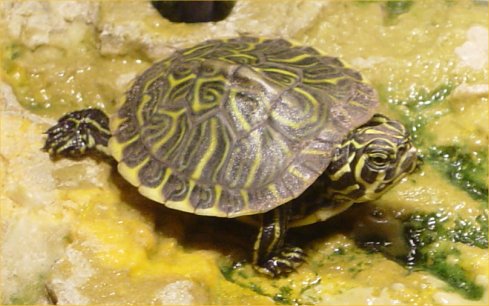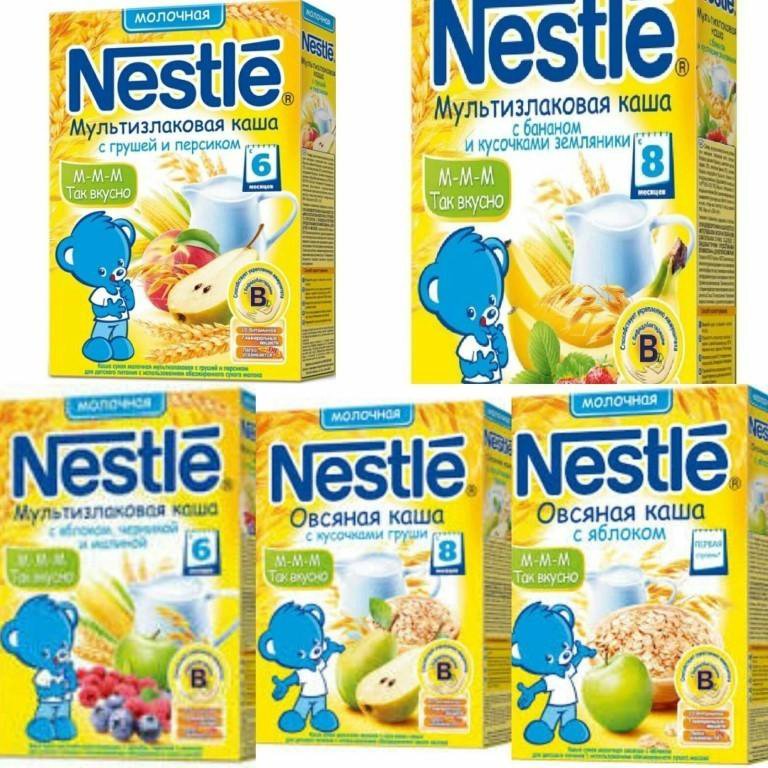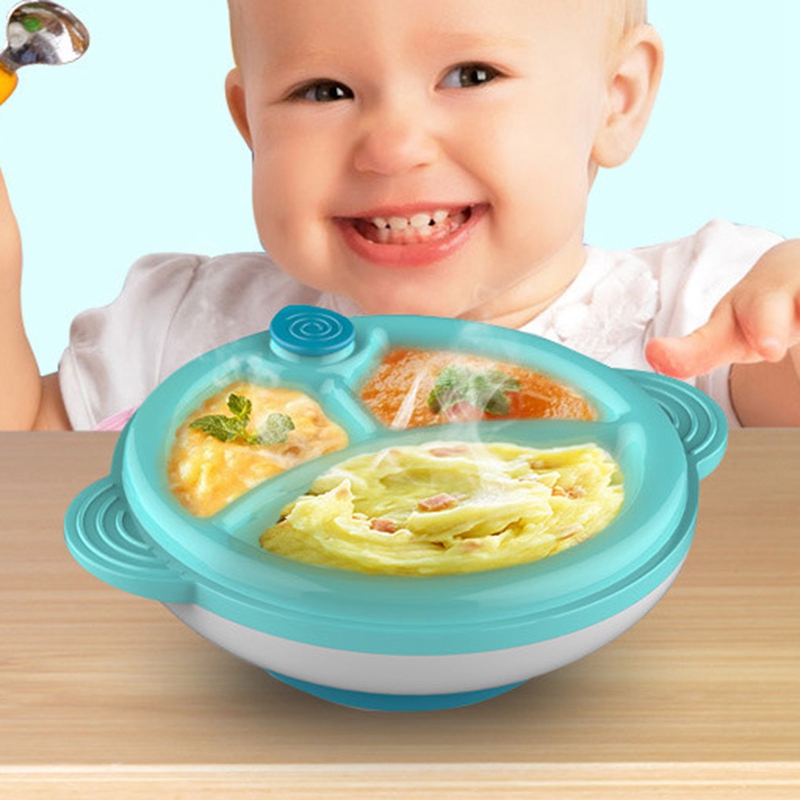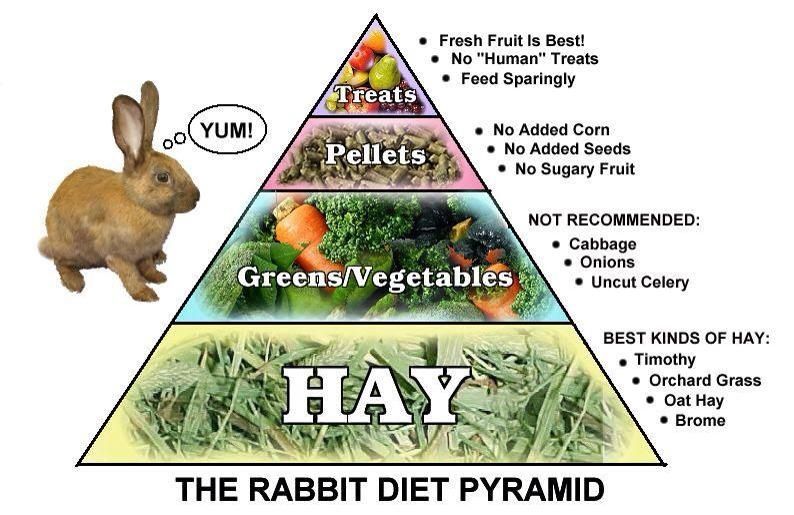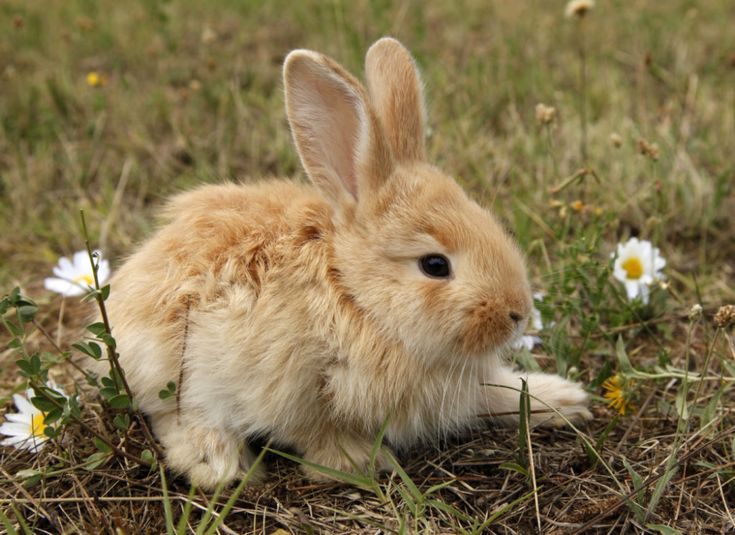What do you feed baby yellow belly turtles
Yellow-Bellied Slider Care, Diet, Size & Tank Setup
Yellow-bellied sliders are one of the most common species of turtle in the eastern United States. If you have ever seen turtles basking on a log near the east coast, there is a good chance you have already seen one!
These common turtles also make great pets. Their striking yellow and black colors, high activity levels, and unique aquatic lifestyle make them a standout pet.
However this unique lifestyle also makes them difficult for beginners to keep. They need a very large enclosure with lots of fresh water and eat a diet of mostly fresh vegetables.
If you are interested in owning on a slider then keep reading for tips on their care, diet, tank setup and more…
Table of Contents
- Species Introduction
- Are Yellow-Bellied Sliders Good Pets?
- Yellow-Bellied Slider Care
- What Do Yellow-Bellied Slider Turtles Eat?
- Tank Setup
- Enclosure Size
- Water
- Lighting and Heating
- Substrate
- Décor and Plants
- Health and Lifespan
- Appearance
- How Big Does A Yellow-Bellied Slider Turtle Get?
- Behavior
- Handling
- Buying Guide
- Facts
- Summary
Species Introduction
Male Yellow-Bellied SliderYellow-bellied sliders (Trachemys scripta scripta) are members of the Emydidae family. This family is home to over 50 different turtle species and includes terrapins and marsh turtles.
Originally named Testudo scripta in 1792 the species was renamed to Trachemys scripta scripta in 1857 by American biologist Louis Agassiz.
In the wild, yellow-bellied sliders are found in the southeastern United States near bodies of water like estuaries, lakes, marshes, and swamps. The name “slider” comes from their tendency to slide off logs and muddy banks into the water at the first sign of danger.
These turtles are a vibrant yellow and black with striped legs, neck, and head. The bottom part of their shell (i.e. plastron) is bright yellow with dark smudges or spots. The top is normally dark green or black.
Hatchlings are born about the size of a quarter and grow to be a foot in length after eight years. But, they continue to grow slowly for their entire lives and can end up weighing over seven pounds.
As they grow, sliders change their diet from primarily protein-based to a plant-based one. Pet species should eat mostly leafy green vegetables, supplemented with protein from insects. Pelleted turtle food is also a good choice.
Pet species should eat mostly leafy green vegetables, supplemented with protein from insects. Pelleted turtle food is also a good choice.
Yellow-bellied sliders are a semi-aquatic turtle. This means they spend most of their time swimming, but sometimes they come on to land to bask and rest in the sun. To accommodate their lifestyle, their tank setup will need to be mostly water that is deep enough for them to fully submerge.
Are Yellow-Bellied Sliders Good Pets?
Yes, they make great pets and are charming, cute and active. Slider turtles became popular pets in the 1950s as hundreds of turtle hatchlings were sold throughout the United States.
Sliders are great pets for those who are not afraid of taking on a long-term commitment. Be prepared to go through a lot of fresh vegetables and do not expect to have a cuddly pet. These turtles are not a good choice for keepers who want to handle their pets. They become easily stressed if held and are known to carry salmonella.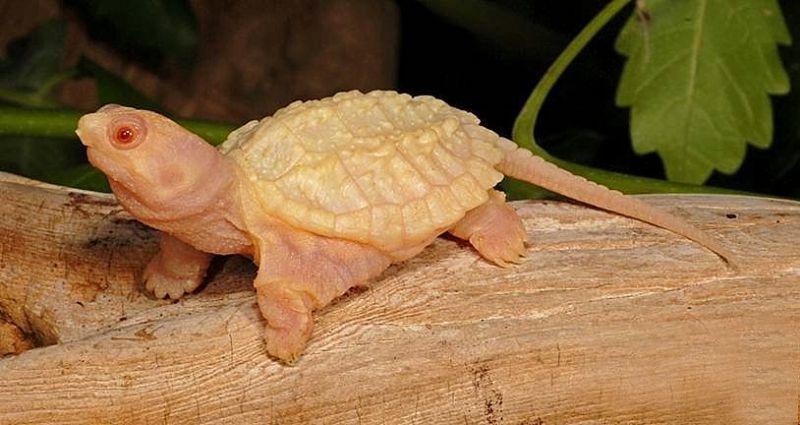
Luckily, they are just as entertaining when left in their tank and are usually bold and inquisitive.
Sliders are entertaining reptiles with a lot of personality, perfect for an intermediate reptile keeper! They are very active during the day and are known to dive, swim, bask and dig.
Yellow-Bellied Slider Care
The trickiest part of caring for this turtle is keeping their enclosure clean. Unfortunately, many first time owners keep these pets in poor conditions which can cause outbreaks of salmonella. But, this should be no problem for intermediate and experienced herpetologists.
They make fantastic pets if given enough space and fed the right diet.
What Do Yellow-Bellied Slider Turtles Eat?
Yellow-bellied sliders are opportunistic feeders who eat whenever and whatever they can. This is not surprising given similar species, such as the snapping turtle, are also opportunistic feeders.
What is surprising is that their diet changes as they age.
Young turtles are primarily carnivores that feed on aquatic insects, worms, and small fish. As they grow into adults, their diet shifts to one that is made up almost entirely of plants!
Good Foods
- Carrot Tops
- Parsley
- Kale
- Turnip Greens
- Collard Greens
- Apples (As A Treat)
- Green Beans
- Water Lilies
- Red Bell Pepper
- Duckweed
- Waterweed (Elodea)
Bad Foods
- Iceberg Lettuce
- Feeder Fish
- Raw Meat
- Spinach
- Beets
- Rhubarb Greens
- Potato Greens
There are several high-quality aquatic turtle diets that are usually in the form of pellets. But, keep in mind that most of these diets are made for adult turtles rather than hatchlings. They can lack the protein needed by juveniles.
Baby turtles do best when fed small crickets, mealworms and cockroaches four times a week. You can also feed pieces of Romaine lettuce, dandelion greens and other vegetables, so that 1/3 of their diet is plant-based.
You can also feed pieces of Romaine lettuce, dandelion greens and other vegetables, so that 1/3 of their diet is plant-based.
Growing turtles can be given two small meals every day. Gradually introduce more fruits and vegetables into your turtle’s diet, along with food pellets formulated for adults.
Fully grown turtles should be fed mostly pellets and leafy greens, along with some aquatic plants like duckweed.
Adults can also be fed crickets, shrimp, mealworms, and earthworms if you are not feeding pellets. Unlike juveniles, adults only need one meal every other day, with only 50% of their diet consisting of protein. To ensure proper nutrition, dust your turtle’s food with a multivitamin once each week.
Tank Setup
Yellow-Bellied Slider In An AquariumYellow-bellied sliders are mostly aquatic and live in brackish and freshwater marshes, wetlands, lakes, and ponds in the southeastern United States.
Keeping sliders in a tank is relatively easy, provided you have the proper setup and equipment.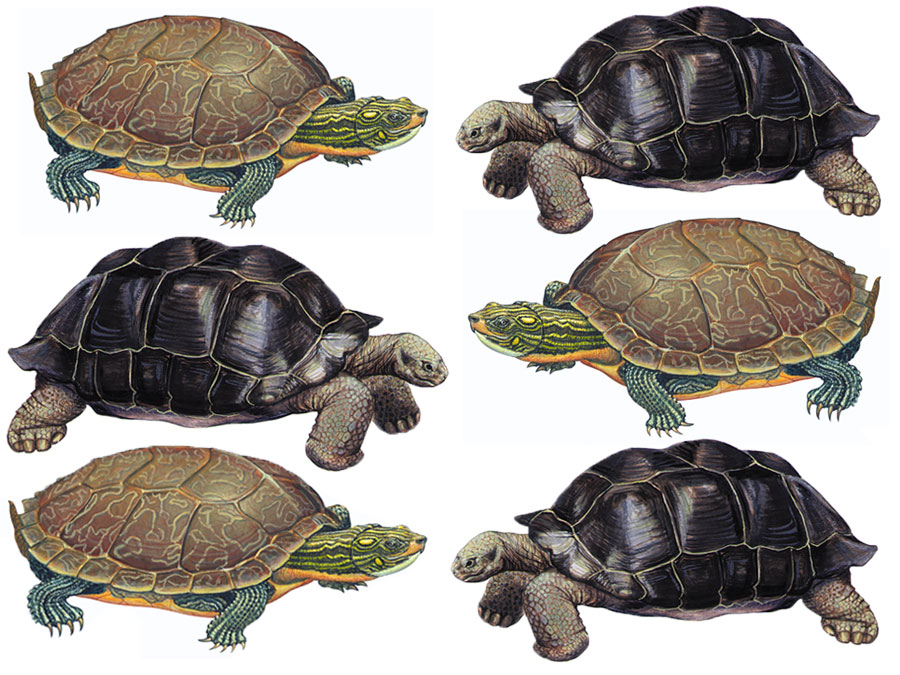 They need a tank with water deep that is deep enough to submerge in with plenty of plants along the bottom.
They need a tank with water deep that is deep enough to submerge in with plenty of plants along the bottom.
Enclosure Size
When you first get a turtle hatchling you will need a 30-gallon tank. But, this should be changed for a larger tank after four years. Adult sliders need at least a 100-gallon enclosure to be healthy. Some owners use a standard glass fish tank to house their slider, while others use plastic pond liners to create a more natural setup.
Water
The tank water should be kept at 72 to 80°F with an underwater heater, and must be properly cleaned with a powerful aquarium filter. Sliders can thrive in freshwater, though brackish water can also be used. Brackish water for turtles can be a simple 50/50 mix of fresh and salt water (around 1.01 SG).
Water should be treated with a turtle-safe dechlorinator and be free from heavy metals and other pollutants. If you use brackish water, make sure to measure the salinity frequently, as the salt levels will increase as water evaporates.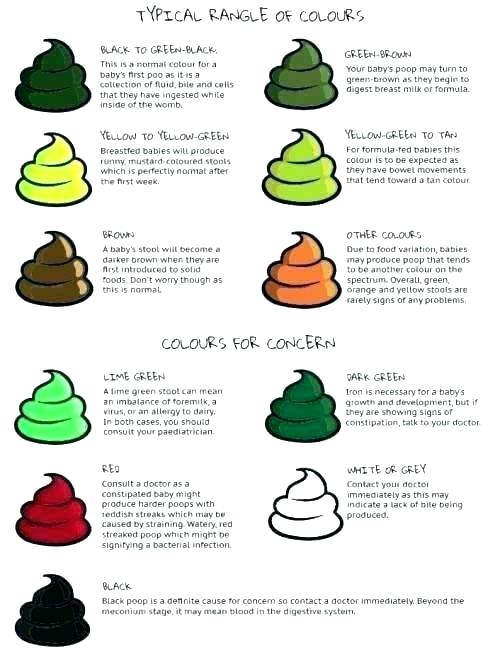
Lighting and Heating
Turtles need to warm up before they can become active. Your Yellow-Bellied slider should have a basking spot on land that reaches 90 to 100°F, as well as a cooler area that is 72 to 76°F. Both UVA and UVB lights are essential for sliders metabolize calcium. A 5% UVB bulb, often marketed as a “tropical UVB” bulb, is ideal for sliders.
Substrate
Yellow-Bellied sliders need mostly water in their tank. In the water, the best substrate for sliders is no substrate or fine sand. Turtles can accidentally ingest gravel or pebbles, which can cause gastrointestinal impaction.
Some land should also be provided for basking. Adding a plastic or wooden platform to the side of the tank is important. It should be large enough for your slider to sit comfortably on.
Décor and Plants
Yellow-bellied sliders enjoy having plenty of hiding places. On land, live plants, flowerpots, plastic boxes, leaf litter and wooden logs are great décor options.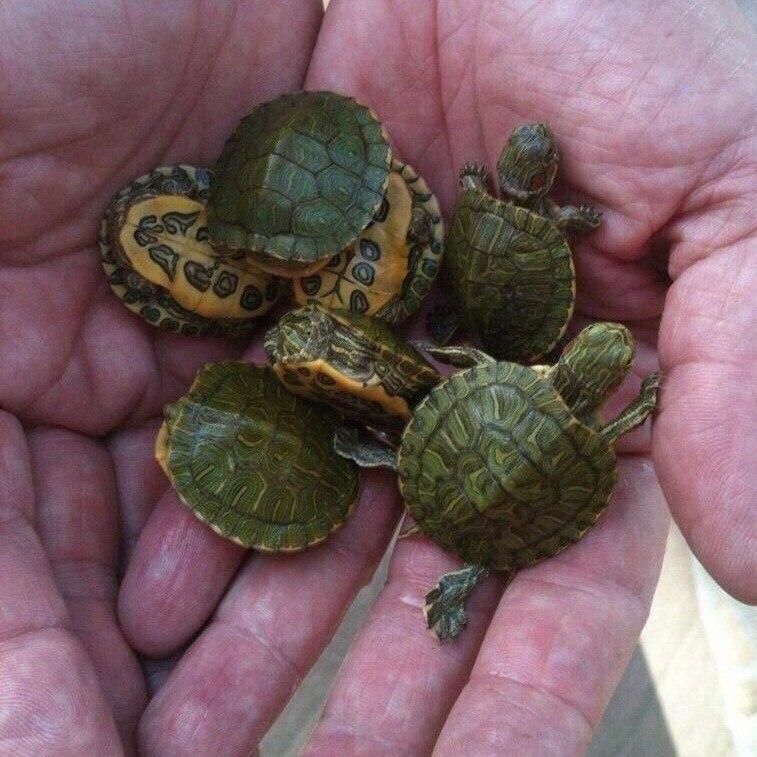
Live plants like waterweed, anubias, and mosses can be used in the water portion of your tank, but keep in mind that they may be munched on.
Health and Lifespan
Yellow-bellied sliders live for an incredibly long time. Many are able to live for 40 years! In the wild, their long lifespan is partly because of their tough shell, which prevents attacks from other animals.
Unfortunately, this protection comes with a downside. As their shell is their main line of defense, slider turtles put less energy into their immune systems. This makes them more vulnerable to bacterial diseases like mycoplasmosis and shell rot.
- Mycoplasmosis is a bacterial infection that causes respiratory irritation. Infected turtles have a runny discharge from the nose, bubbles around the mouth and audible breathing.
This disease is extremely infectious and passes from turtle to turtle through mucus. If you suspect your turtle may be infected, make sure to isolate and take it to a veterinarian.
- Shell rot is also a bacterial infection that affects turtles.
Also known as ulcerative shell disease or ‘rust,’ it is caused by bacteria from dirty water. Shell rot appears as gray, white, or red flaky or slimy spots on the top and bottom of the shell. If left untreated shell rot can cause open sores and secondary infections. The best way to prevent shell rot is to keep your turtle’s tank clean and monitor it for any injuries.
Regular cleaning and tank maintenance is the best way to keep your turtle healthy.
Signs They Are Healthy
- Even-colored shell with no abrasions.
- Strong, active swimming.
- Eating lots of food.
Sickness Symptoms
- Red and white patches on the shell.
- Floating at the top of the water, inability to dive.
- Closed or puffy eyes.
Appearance
Female Yellow-Bellied SliderYellow-bellied sliders are beautiful turtles with black and yellow markings.
They are named after their yellow shell. The bottom and sides of their shell are a bright yellow with three to four black spots on each side. The top of their shell is a dark brownish green with orange and black wavy lines.
As they age, their shell often becomes darker in color, especially on the top. Males in particular can become almost black!
Sliders have shells that are flattened and smooth. This makes them more aerodynamic for swimming and provides a larger surface area to soak up the sun when basking.
To help them swim yellow-bellied sliders have strong legs with webbed toes. They also have long sharp claws that help them build nests as well as climb on logs, rocks and muddy banks.
Yellow-bellies are recognizable for the V-shaped yellow mustache on their beaks, as well as a bright yellow spot behind the eye. This spot stands out more in juveniles and females.
This species is not bred for color morphs, but you can sometimes find albinos for sale. Albinos lack pigment in their skin, and so are pink and yellow instead of the typical black and yellow.
Albinos lack pigment in their skin, and so are pink and yellow instead of the typical black and yellow.
How Big Does A Yellow-Bellied Slider Turtle Get?
Sliders are large turtles with an average shell length of five to nine inches. However, they are a sexually dimorphic species, meaning there is a significant difference in size between males and females. Males average seven inches long and females are closer to ten inches.
Because of their long lifespan, this species grows very slow. Males reach maturity in five years and females take eight years. Females mature slower in order to build up enough energy to produce eggs.
Behavior
Yellow-bellied sliders are diurnal, just like humans. They are most active during the day. In the wild, they are often found in groups clustered around the best basking spots. However, these turtles can be territorial and prefer to live alone as pets.
As a pet, this species is very active and spends most of its time swimming, diving and basking.
When startled, sliders will quickly “slide” into the water to escape. Though more suited to swimming, these turtles are surprisingly quick on land and can sprint short distances.
If tank temperatures are warm enough, you will most often find your Yellow-bellied turtle in the water rather than on land. Sliders are great swimmers and often sleep underwater, but they still need access to land to survive.
Yellow-bellied sliders like to rest on logs and banks throughout the day to bask and raise their body temperature.
Your turtle will move in and out of the water to keep its internal temperature at a constant level.
The cooler your turtle is the slower its movements and activities will be. In the wild sliders hibernate during the cold winter months, but in captivity, where temperatures are constant, they are active year-round.
Handling
Yellow-bellied sliders are not the most affectionate pet. Holding them can cause stress, and a stressed turtle will not hesitate to bite any fingers it can reach.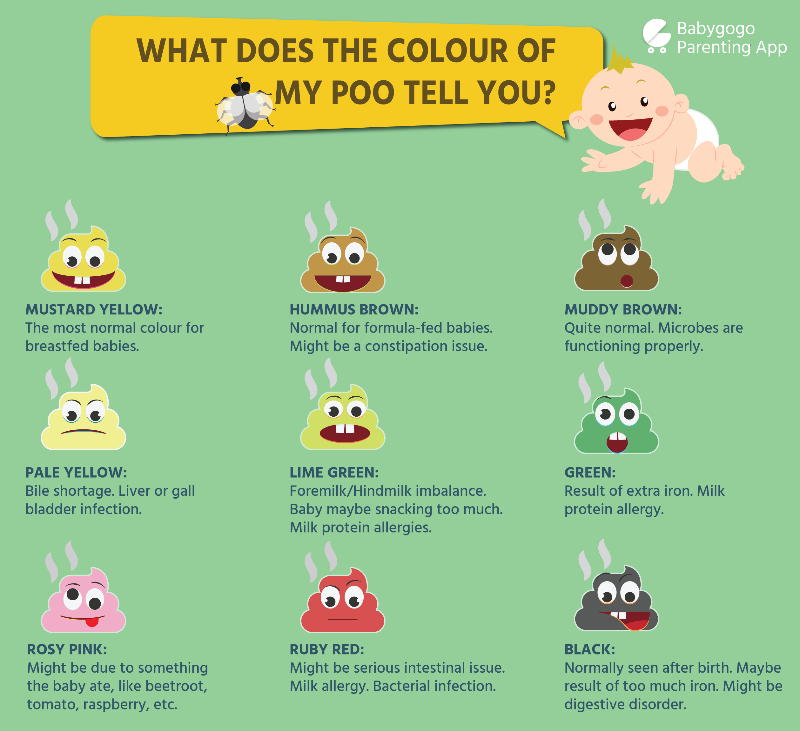 Their long, flexible necks give them a surprisingly long reach.
Their long, flexible necks give them a surprisingly long reach.
If held yellow-bellied sliders will normally pull their heads and arms into their shell.
With regular and gentle handling your slider may become more relaxed, but they do best if left alone. If you must pick up your turtle, grasp it firmly with two hands as if it were a hamburger.
Always wash your hands before and after handling turtles, and avoid letting small children hold them. Pet turtles are a significant cause of salmonella cases in the United States, which can be deadly to children and people with compromised immune systems.
Buying Guide
The sale of turtles with a shell length of fewer than four inches is illegal in the U.S.
Juvenile yellow-bellied sliders are commonly sold online and at reptile shows. Depending on the seller they can cost $30 to $80.
It is also easy to find adults for sale because of their long lifespan. It is not unheard of for people to sell 20-year-old turtles. Buying an adult is not only more responsible, but also gives you a greater chance of getting a healthy pet.
Buying an adult is not only more responsible, but also gives you a greater chance of getting a healthy pet.
The most expensive part of owning a slider is the tank and its setup. A 100-gallon tank and accessories will cost over $300.
When looking to purchase a yellow-bellied slider, make sure you are buying a captive-bred turtle from a good breeder. Healthy turtles should be alert and try to escape if approached by a person.
Facts
| Quick Summary Table | |
|---|---|
| Common Name (s) | Yellow-bellied Slider, Pond Slider, Yellow-bellied Terrapin |
| Scientific Name | Trachemys scripta scripta |
| Family Name | Emydidae |
| Genus Name | Trachemys |
| Range | North and South Carolina, Georgia, Alabama, Mississippi, northern Florida |
| Adult Size | 5 to 12 inches in length 1.5 to 7 pounds |
| Lifespan | 20 to 40 years |
| Similar Species/Popular Alternatives | Red-Eared Slider, Painted Turtle, Box Turtle |
Summary
Yellow-bellied sliders make great pets. They are energetic, beautiful to look at and have many interesting behaviors. They also enjoy swimming and are very active during the day.
They are energetic, beautiful to look at and have many interesting behaviors. They also enjoy swimming and are very active during the day.
If you are interested in purchasing a yellow-bellied slider, expect to take home a lively, engaging pet that will remain active for over 20 years.
But, do not adopt one of these turtles without thought.
To meet their needs, they need a lot of space and clean water. This requires lots of equipment, such as an aquarium filter, pump, heater and 100-gallon tank. These attractive turtles also like variety in their diet and thrive on a mix of insects, fresh vegetables and pellet food.
Already have a yellow-bellied slider? Let us know your experience in the comments!
Feeding Yellow Belly Slider Hatchlings
By Ben Teami Zedcor Wholly Owned/PhotoObjects.net/Getty Images
Turtles are long-lived creatures who in captivity or otherwise are susceptible to nutritional deficiencies and diet-related health problems; feeding is one of the most important aspects of their husbandry. The natural diet of turtles varies by species, age and sometimes gender. Hatchling yellow-bellied slider turtles need a varied diet of insects, fish and plant material.
The natural diet of turtles varies by species, age and sometimes gender. Hatchling yellow-bellied slider turtles need a varied diet of insects, fish and plant material.
Yellow Bellied Biology
Yellow-bellied slider turtles (Trachemys scripta scripta) are native to the southeastern United States, where they inhabit lakes, rivers, ponds and man-made canals. They are dietary generalists that consume insects, fish, amphibians, aquatic vegetation, algae and carrion. Despite their dietary flexibility, yellow-bellied sliders exhibit age-related shift in food habits; while young turtles are largely carnivorous, adults primarily consume plant material.
General Feeding Procedures
Yellow-bellied sliders eat in the water. When providing food, drop a few items into the water near the turtles. Healthy turtles will usually swim right over and immediately begin eating. Don’t saturate the tank with food items; provide only as much food as your turtles will consume within five to 10 minutes. Young turtles should be fed at least once per day, but if it is feasible, two meals will encourage faster growth.
Young turtles should be fed at least once per day, but if it is feasible, two meals will encourage faster growth.
Insects
Insects -- especially aquatic larval stages -- are an important part of the diet of yellow-bellied sliders in the wild, and they should form a high percentage of your pet’s diet as well. You can feed your pet crickets, mealworms, super-worms or roaches, and it is a good idea to rotate them to provide a more varied diet.
Fish
Fish are an excellent dietary component for turtles, though some turtles may have trouble catching them. The turtles will usually catch slow swimming species, but frozen-thawed or freshly killed fish allow the young turtles to catch their dinner easily. While live fish do provide supplemental exercise and stimulation, they can spread parasites and disease to your turtles; obtain live feeders only from reputable sources.
Fruits and Vegetables
It is good practice to get your young turtle accustomed to eating plant material; older turtles who refuse vegetables and consume a completely protein-based diet may develop health problems. Offer your pet small pieces of strawberries, blueberries, collard greens or squash. Prevent spoiling the water quality by removing any uneaten fruit or vegetables after 12 to 24 hours.
Offer your pet small pieces of strawberries, blueberries, collard greens or squash. Prevent spoiling the water quality by removing any uneaten fruit or vegetables after 12 to 24 hours.
Commercial Foods
Many commercial foods are available for pet turtle owners. While commercial turtle pellets can be a quality component of your yellow-bellied turtle's diet, they should not form the entire diet. The mess that commercial pellets cause partially offsets the convenience of these products. When a turtle bites into a pellet, numerous particles are released into the water. Counteract this by selecting the smallest pellet size that is practical.
References
- North Hampton Reptile Centre: Yellow Bellied Slider Care Sheet
- Austiin's Turtle Page: Yellow Bellied Slider
- The Turtle Source: General Care of Sliders and Cooters
- United States Geological Survey: Trachemys Scripta Scripta
- Animal Diversity Web: Trachemys Scripta
- TurtleTails.
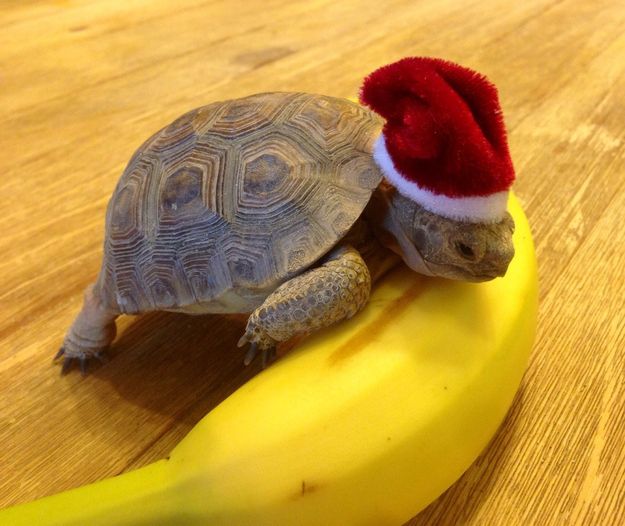 com: Feeding Baby Turtles
com: Feeding Baby Turtles
Resources
- Savannah River Ecology Laboratory: How Do Baby Turtles Survive Winter?
Photo Credits
Red-eared turtle: maintenance and care at home
This type of turtle is classified as a freshwater reptile. Its main feature is longish red-orange spots that are located just behind the eyes. Despite the fact that they do not have ears, they hear perfectly. Since the shield on their belly is colored bright yellow, they are also often referred to as yellow-bellies. The females of these animals are usually much larger than the males. Puberty of these animals occurs at 4 years.
The content of the article
- Red-eared slider conditions
- What you need to buy to keep a turtle
- Red-eared turtle feeding
- Handling of babies
Red-eared slider conditions
To keep such a reptile, you will definitely need an aquarium or terrarium, with a volume of 150-200 liters. Make sure the turtle has enough water to move freely. Ideally, the more swimming space she gets, the better.
Make sure the turtle has enough water to move freely. Ideally, the more swimming space she gets, the better.
In addition, artificial land must be created for it, on which the reptile can get out to warm itself. The island must have a sloping rise, stability, as well as the absence of burrs and sharp corners.
The island should occupy at least ¼ of the surface of the terrarium and meet certain requirements.
- Heating . The temperature on it must be set at least 10 ° C higher than in water. Too high a temperature also does not need to be set, as the reptile can overheat.
- Flooding . On an island, at least one side must be in the water.
- Security . The reptile should move freely and not get stuck between the island and the glass.
- No toxicity . No toxic substances should be released from it.
- Stability . The land must stand very securely, since this type of turtle is very strong and can easily turn it over.

- Textured surface .
What do I need to buy to keep a turtle?
The most necessary things:
- 200 liter turtle tank.
- Aquarium Water Heater 100W.
- Aquarium filter (internal, but external is better).
- UV lamp for turtles with UVB 10%.
- Lamp for heating.
- Aquarium lamp.
- Thermometer.
- Land, coast, island.
Red-eared turtle feeding
Omnivorous, feeding on a wide variety of food. Variety is important as it keeps the turtle healthy. You can feed: food for turtles, food for aquarium fish, vegetables, aquarium plants, insects, fish, invertebrates. In addition to variety, it is important to give a balanced diet high in calcium. Like all wild animals that live at home, there is a tendency to overeat.
The composition of specialized feeds is selected in such a way as to give turtles all the necessary substances. The high protein content of commercial feeds allows them to be fed in small portions.
To make the feeding more balanced, add calcium and vegetable foods and your turtle will be quite happy. Please note that calcium supplements are most often already included in commercial feeds, read the labels on the packaging.
Red-eared turtles need water to swallow because they do not produce saliva. They may take food on land, but will drag it into the water to eat. You can use this to your advantage and feed them in a separate container, so the water in the aquarium will remain clean for a longer time.
Tetra, Fiori, Sera food is perfect.
As for hibernation, which the reptile can fall into during the winter period, it is desirable to avoid it. The thing is that if you are new to keeping this type of turtle, then you may simply not have enough experience in caring for it in this period. Therefore, it is not necessary to stimulate hibernation in this reptile! Firstly, unfavorable conditions may be created for it during this period, and secondly, weakened animals may simply not survive it.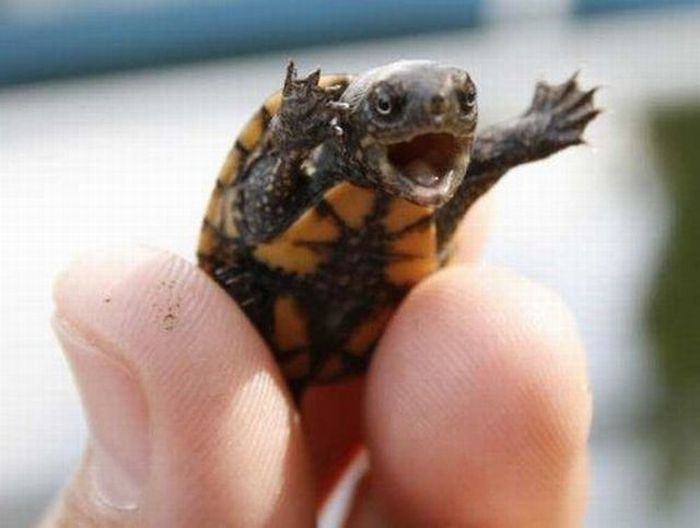 To prevent it from falling into hibernation, keep the temperature at a level of at least 25 ° C, and the reptile will not even remember about a long winter sleep.
To prevent it from falling into hibernation, keep the temperature at a level of at least 25 ° C, and the reptile will not even remember about a long winter sleep.
Turtles that hibernate under natural conditions tend to burrow into plants or silt at the bottom of a reservoir that has a shallow depth and large dimensions. During this period, reptiles remain at the bottom all the time, oxygen is absorbed by them through membranes located in their mouth, pharynx and cloaca. In addition, the depth of the reservoir, the temperature regime and the level of oxygen in it are of great importance.
Baby care
Most turtles that appear in a home aquarium are still babies. They are still very tender and it is important to make sure they eat well and are comfortable. Cubs have a high mortality rate, are susceptible to disease, and can die for no apparent reason.
If you notice something on your turtle's plastron, it could be the yolk sac. Newly hatched turtles consume nutrients from it and should not be removed or touched.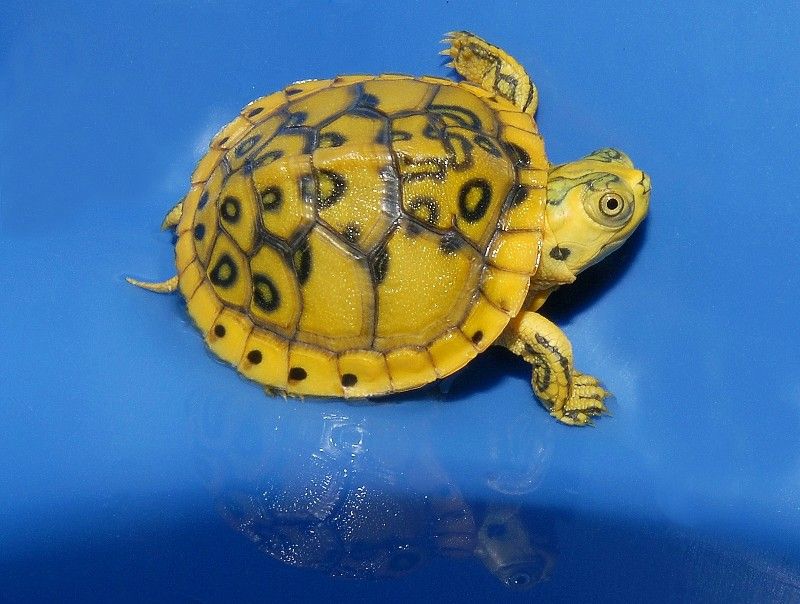 They may refuse food during the first time, and begin to eat after the yolk sac is completely resolved.
They may refuse food during the first time, and begin to eat after the yolk sac is completely resolved.
Try not to hold small turtles in your arms. Of course, they are beautiful and elegant, but at the same time they can get scared, get stressed and get sick. Do not stand over the aquarium and do not knock on the glass, let them get used to it for a few days, start eating. It is very important that the temperature of water and air (land) be stable.
It is impossible to put an aquarium with a red-eared turtle in direct sunlight or in a draft. Make sure that she has free access to land and this place is heated with a special lamp. Keeping temperature for baby turtles should be slightly higher than for adult turtles! This is 26-27 o C for water and up to 32 o C for land. Water should be as clean as possible and if there is no good filter, then change every couple of days
Little turtles home care. How to care for a water turtle at home.
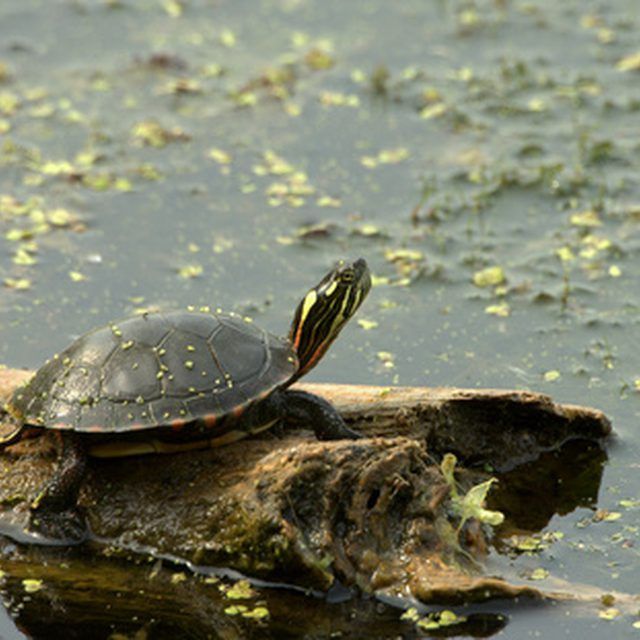 Features of feeding, possible diseases
Features of feeding, possible diseases On the pages of our site, we described the features of keeping terrestrial and red-eared turtles (read more about this), and even. However, many of our readers are interested in the question of whether there are miniature turtle breeds that can be kept at home? Not everyone can afford to install a full-wall aquarium at home. But if the turtle lived in a small aquarium, differed in miniature size, and was quite unpretentious in terms of care, it would be an ideal candidate for the role of a pet.
These types of small turtles do exist and can even be purchased from pet stores. Now we will briefly tell you about them and about the main points of their comfortable content in your home.
Small turtle species for home keeping
Small turtles are those which, even as adults, do not reach a length of more than 12 centimeters. If the turtle has a body length of more than 15 centimeters, it is already classified as a medium-sized pet, and it needs a special move. All other turtles (up to 15 centimeters) are classified as mini. However, you should be aware that if you buy a turtle in small sizes, then in childhood it may be only a few centimeters long, while over time it will definitely grow a little. This is a natural process and you should be prepared for this - you may need to buy a larger aquarium in a couple of months to comfortably keep your aquatic pet.
All other turtles (up to 15 centimeters) are classified as mini. However, you should be aware that if you buy a turtle in small sizes, then in childhood it may be only a few centimeters long, while over time it will definitely grow a little. This is a natural process and you should be prepared for this - you may need to buy a larger aquarium in a couple of months to comfortably keep your aquatic pet.
Flat or flat turtles
In nature, these creatures live in Africa, Mexico and America. 4 subspecies of these turtles are known, but Sonoran and yellow locking turtles are more popular . They reach sizes in adulthood up to 13 centimeters. But the striped and silty reddish turtles grow a little less - up to 11 centimeters.
Excellent contenders for the role of a pet. As adults, they rarely grow longer than 15 centimeters. At the same time, 4 of their species are also known. Representatives of each species differ in their color and size.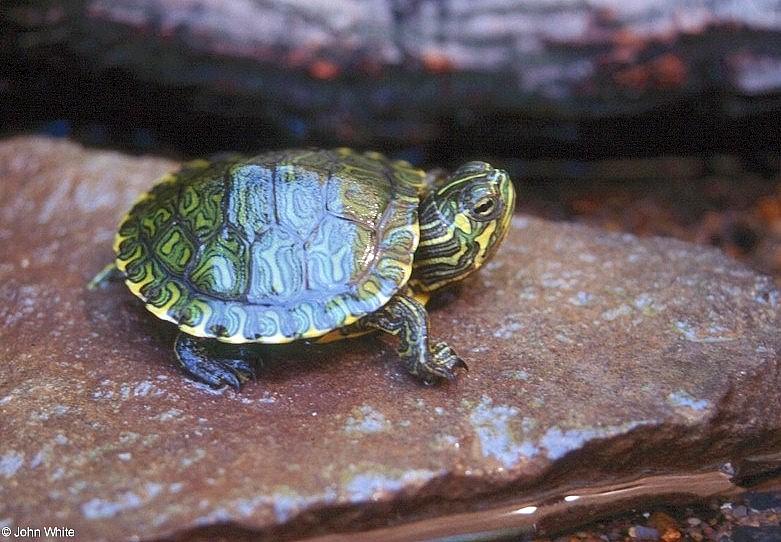 Sternotherus depressus is considered to be the smallest - the size of an adult does not exceed 11 centimeters.
Sternotherus depressus is considered to be the smallest - the size of an adult does not exceed 11 centimeters.
These turtles cannot be classified as fully aquatic creatures, as they don't mind getting out and staying on dry land for a while. So, they are half water, half land creatures, and for them to live comfortably in your home, you will need to take care of a terrarium aquarium that could provide them with a comfortable habitat for them, providing both a land area and an artificial reservoir. Fortunately, the size of an adult turtle is no more than 13 centimeters, so it is not necessary to equip a very large house for them.
On average, the body length of an adult does not exceed 13 centimeters. Attractive appearance, unpretentiousness in terms of maintenance requirements, calm nature - all this makes these creatures the favorites of turtle farmers, and especially those who do not have much experience in keeping turtles.
Benefits of keeping baby turtles
If you dream of having an exotic pet in your home, but the small size of your home does not allow you to have a large animal, mini turtles are what you need.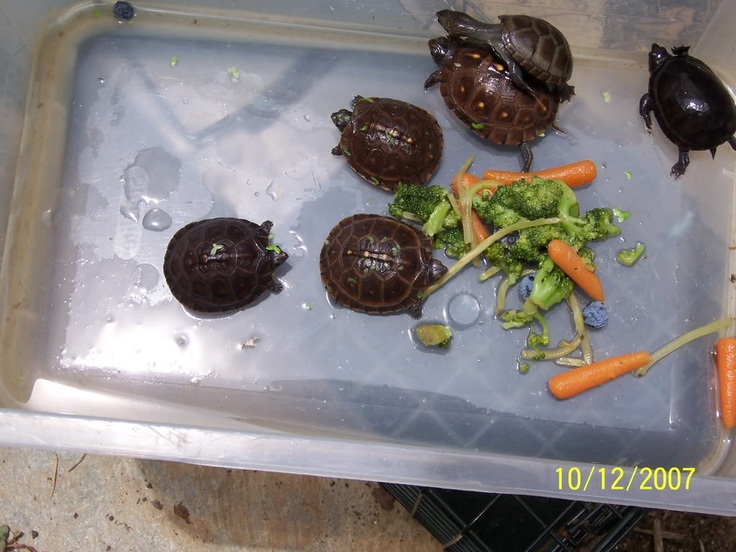 The unusual appearance of the pet, the absence of special requirements in terms of care, a calm nature - such turtles can be started both by those people who spend a lot of time at work, and those who like to watch the life of pets for a long time behind the glass of an aquarium. Even a teenager can handle the simple care of a mini turtle, and having one makes them more responsible and obligatory.
The unusual appearance of the pet, the absence of special requirements in terms of care, a calm nature - such turtles can be started both by those people who spend a lot of time at work, and those who like to watch the life of pets for a long time behind the glass of an aquarium. Even a teenager can handle the simple care of a mini turtle, and having one makes them more responsible and obligatory.
The red-eared or yellow-bellied tortoise is the most common reptile among animal lovers. People call it a sea turtle, although it lives in fresh water. In pet stores, small turtles attract customers with their unusual coloring, pretty appearance. By purchasing it, people do not know how to care for a sea turtle.
The sea turtle does well at home, so it is suitable for beginners. They are considered long-livers (20–40 years), subject to the rules of care. By nature, the reptile is sometimes aggressive, while being strong and fast. When it comes to food, the red-eared turtle shows mental abilities.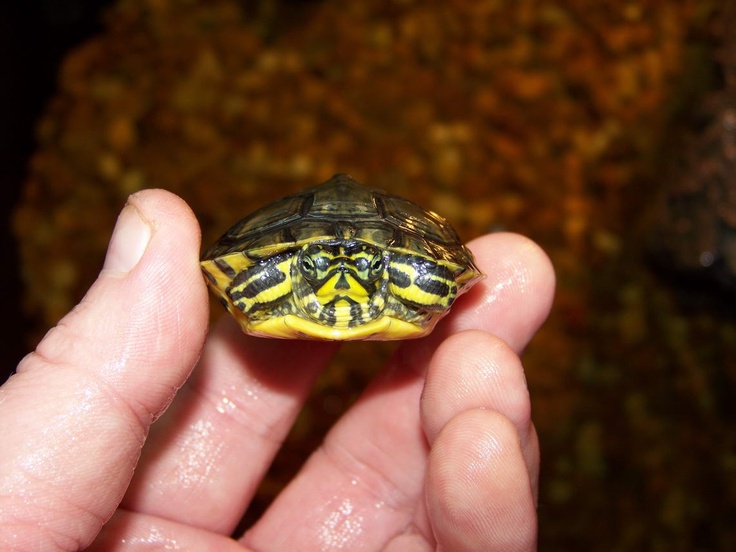 Therefore, in the wild in Australia, they supplanted their counterparts and are now considered outlaws and exterminated.
Therefore, in the wild in Australia, they supplanted their counterparts and are now considered outlaws and exterminated.
Buying a yellow-bellied tortoise
When buying a reptile in a pet store or in the market, it is recommended to take it to a veterinarian for examination. This is necessary to determine the general condition, whether there are diseases, and to view for injuries.
If you already have sea turtles at home, and you have purchased another one, then the new one must be kept separately for 90 days. And also it is impossible to keep adults and small ones in one place, this can lead to injury to the latter. Only turtles of approximately the same size are kept together.
After a change of residence, the turtle behaves sluggishly or vice versa, actively. During this period, you must not disturb her, but do not forget to feed.
Handling
When a person wants to pick up a turtle, it is recommended to remember that it is wet and slippery. She does not like these manipulations, so she hisses, can scratch, as she has large claws, and is even able to bite. Therefore, the pet must be held simultaneously with both hands.
She does not like these manipulations, so she hisses, can scratch, as she has large claws, and is even able to bite. Therefore, the pet must be held simultaneously with both hands.
After the time spent together with the reptile, you need to wash your hands with hygiene products, as it is a waterfowl, and there is its own microflora. Make sure that the feed and water in the tank are fresh. Turtles carry salmonella. Therefore, it is forbidden to wash the reptile in the sink in the kitchen and its accessories too.
What is required for maintenance and care
In order to carry out proper care at home, you need to purchase:
- for 150 liters. aquarium;
- filter;
- water heater;
- lamp;
- UV lamp;
- water and air thermometer;
- island.
These are all things from a long list that a pet needs for a healthy life.
Turtle care
Sea turtles require water and land. Therefore, the first step is to purchase an aquarium in volume of at least 150 liters. If the reptile is small, then it grows relatively quickly. Because of this, it is recommended to buy a container "for growth". Water is poured so that there is enough for swimming and coups for the pet.
If the reptile is small, then it grows relatively quickly. Because of this, it is recommended to buy a container "for growth". Water is poured so that there is enough for swimming and coups for the pet.
An island of sushi is placed in the aquarium and is sold in a specialist shop. The pet will periodically crawl out and bask under the installed lamp. The temperature on land exceeds the water temperature by 10 degrees. The island area should occupy a quarter of the aquarium. But exceeding the temperature regime on the island is unacceptable. This will lead to overheating, which means that care will not be performed properly.
Island requirements:
- one side of the land must be submerged, i.e. half submerged;
- position the land so that the reptile does not get stuck between the glass of the aquarium and the side of the land;
- made of safe materials;
- floated well so that the pet could not turn it over;
- textured surface.

How to heat the island
Turtles love to bask in the sun on the sand. This must be done at home, but instead of the sun there will be a lamp. The reptile feels good when the shell temperature under the lamp is 30-35 degrees. To control this parameter, you must place a thermometer. If the thermometer values exceed the norm, then the pet may get burns. We must not forget that the aquarium contains more than one turtle, they love to climb on top of each other. This makes it dangerous to approach the heating lamp.
When diving, the pet sprays drops in different directions. They can get on a working lamp, as a result, it will burst. So, the lamp is positioned so as to exclude all these moments.
Why you need a UV lamp
Heat and light are the two main components of a pet's health. Therefore, the aquarium is equipped with two lamps for heating and ultraviolet. Under the UV lamp, the body of the turtle absorbs calcium and produces vitamin B.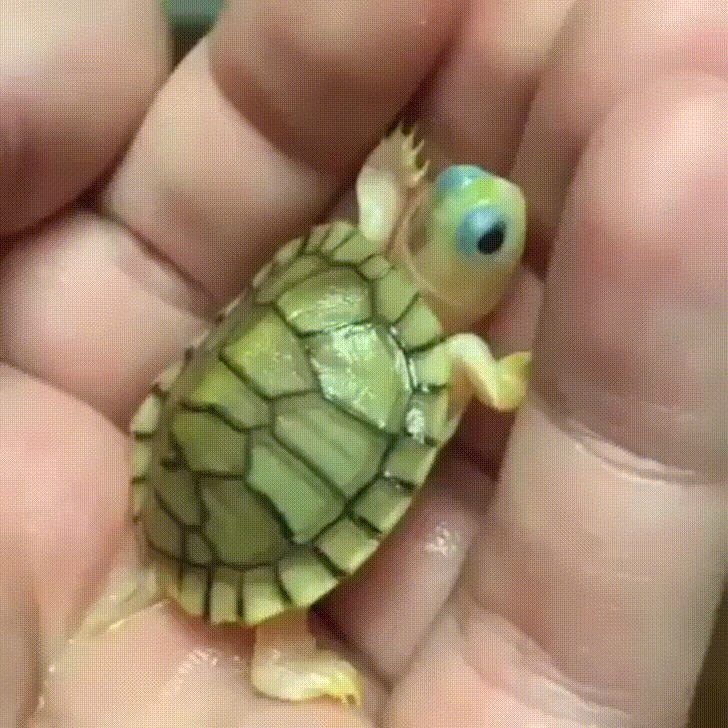 If the body lacks these substances, the pet becomes ill with rickets, and its shell is deformed. The UV lamp is positioned directly above the reptile and must be operated at the same time as the heat lamp for 12 hours a day.
If the body lacks these substances, the pet becomes ill with rickets, and its shell is deformed. The UV lamp is positioned directly above the reptile and must be operated at the same time as the heat lamp for 12 hours a day.
Water requirements
The red-eared turtle is a waterfowl. She feeds, empties herself, sleeps in the water. Therefore, water should always be clean and fresh. Dirty causes discomfort to the pet, is a source of disease.
The smallest water level in a container is measured by the size of its shell. She should calmly roll over on her stomach if she finds herself on her back. But the declared level is the lowest. Ideally, more water is recommended, then it stays clean longer.
When changing the water, it must be left standing for 24 hours. It is important to ensure that the water does not drop to 20 degrees, but is within 22–28 degrees. If necessary, water heating put a heater. The water temperature is controlled with a thermometer.
Since the pet performs all its physiological needs in the aquarium, the water becomes polluted and smells unpleasant.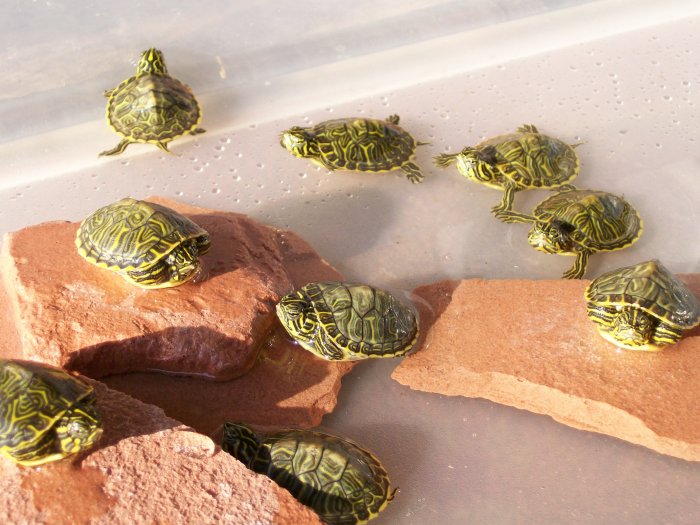 To avoid this, the water is changed once every 7 days. To perform this procedure less often, you need to install a filter. The internal filter with water, after the turtle does not cope, it is weak. Of course, you can buy an external filter, it fits perfectly, but its price is not cheap.
To avoid this, the water is changed once every 7 days. To perform this procedure less often, you need to install a filter. The internal filter with water, after the turtle does not cope, it is weak. Of course, you can buy an external filter, it fits perfectly, but its price is not cheap.
How to feed your pet
Diet of a sea turtle varied:
- artificial food;
- fish;
- fish food;
- vegetables;
- insects;
- aquarium plants.
But with all the variety, it is necessary to control that the reptile does not overeat. To do this, it is recommended at times to use a diet with calcium. Petomitz loves to hunt for his prey, but he does not refuse carrion either. The main thing to remember about adding calcium to the menu. The turtle does not produce saliva while eating, so it pulls food into the water. This can be used to your advantage, that is, feeding the pet in another container of water, then the water in the aquarium will remain clean longer.
It is important to know that the older the turtle, the more plant foods it eats and less protein. Therefore, the diet of an adult or old turtle consists of 25% protein and 75% plant foods.
Hibernation
Under natural conditions, reptiles hibernate during the winter season. If the pet lives at home, then this is contraindicated. Reptile owners may not have the knowledge to properly organize sleep care or be unable to wake the turtle from hibernation.
When getting a pet, a person must understand what responsibility he takes on. After all, any living creature needs proper nutrition, most importantly, the love and attention of the owner.
Small turtles living in the aquariums of a pet shop attract attention not only of children but also adults with their touching appearance and extraordinary coloring. Children often ask to buy such a turtle home. When purchasing a new pet, adults understand that they will have to take care of the animals. And although the turtle is not as noticeable as a dog or a cat, and it is easy to forget about it, it needs feeding and care, like any pet.
Turtle
At home it is possible to keep water turtle. usually gets into the house from the pond of the neighboring park, red-eared is purchased in the store.
What to look for when buying an aquatic turtle:
- Behavior: coordination of movements, activity.
- Appearance: The carapace must be of regular shape with even shields adjacent to each other. It must be free of damage and unsightly stains.
- The oral mucosa of healthy reptiles is light pink in color, without whitishness and plaque.
- Turtle breathing should be silent.
- There should be no discharge from the nose and mouth.
Home turtle
Turtle needs an aquarium , the volume of which depends on the size of the reptile. Its width should be twice as large as its height. When choosing an aquarium, keep in mind that small turtles grow quickly. However, it is not worth acquiring it for "growth". In a large aquarium, a small turtle will feel uncomfortable. It is best to first buy a small inexpensive aquarium, and then replace it with a larger one.
It is best to first buy a small inexpensive aquarium, and then replace it with a larger one.
Setting up the aquarium and caring for turtles
Turtles from time to time crawl out onto land, so the setup of the aquarium should be such that it has a shore. Reptiles will get out on it to warm themselves and crawl.
Immediately note that the plastic island is inconvenient . Turtles slide off it. It is best to pick up a rough, gently sloping coast.
The land in the aquarium should cover approximately one-fourth of the total area. From it to the edge of the container, you must leave at least thirty centimeters of space. Otherwise, the turtles may escape.
If you install a yellow incandescent lamp above the island, the water in the aquarium does not need to be heated. Water should not be heated more than twenty-one degrees. It should be changed quite often to prevent a musty smell. This negatively affects the health of pets.
Small turtles are best taken out of the aquarium and placed in a warm and dry place.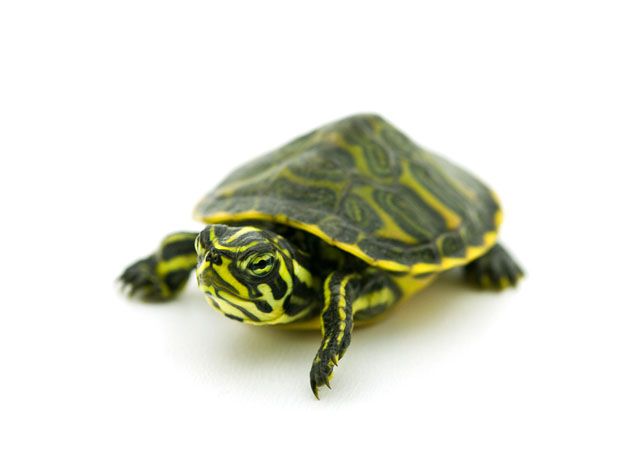 For example, in a box covered with a towel. Then they will grow and develop better.
For example, in a box covered with a towel. Then they will grow and develop better.
Nutrition Features
Baby turtles should be fed every day . When they mature, the number of meals is reduced to once every three days. Sometimes turtles may refuse food, then they need to be fed with guppy fish.
Aquatic turtles must have lean meats (beef, chicken, turkey) and chopped vegetables in their diet. Adult reptiles are recommended to be given supplements containing trace elements, calcium and vitamins necessary for the proper development and growth of the aquatic turtle.
Red-eared or sea turtle
This species of turtle has a dark brown or slightly greenish shell, webbing between the legs and red ear-stripes behind the eyes.
With good care, they can live up to thirty years .
Since sea turtles are water turtles, they should be kept in spacious aquaterrariums. Its device should be the same as for water turtles.
For the aquarium use ordinary tap water, settled for a day.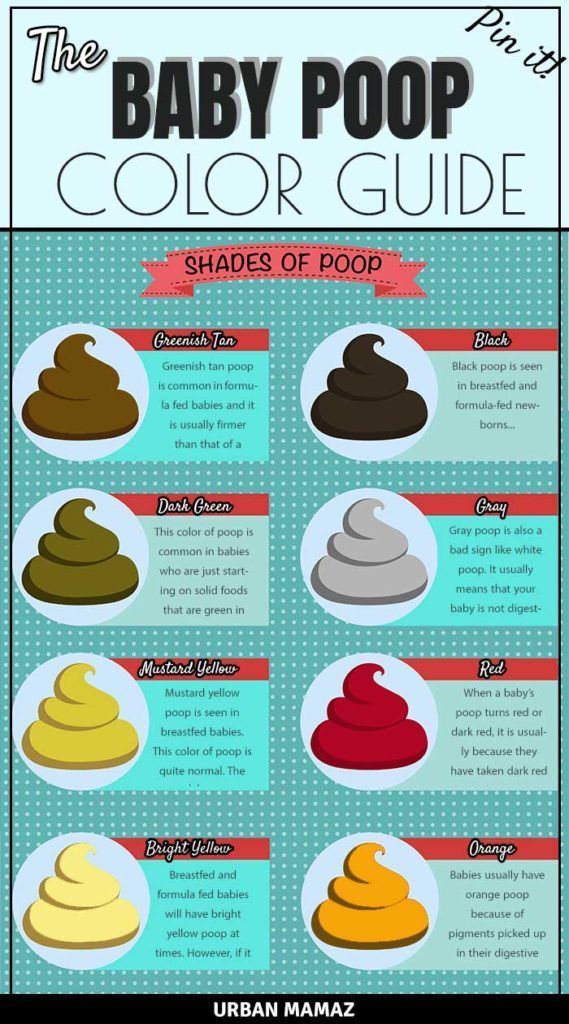 It should be changed once a month. Put pebbles on the bottom of the aquarium.
It should be changed once a month. Put pebbles on the bottom of the aquarium.
To maintain the desired temperature, the aquarium is equipped with an incandescent lamp, and for the good development of turtles - with an ultraviolet lamp.
Nutrition
Since sea turtles are carnivores, meat must be included in their diet , various seafood and fish without large bones. Do not give them fatty fish (sprat, capelin, mackerel).
But meat should not be the main food. If sea turtles are fed only meat, they will inevitably get sick with rickets. The diet of young turtles should include animal feed. For older reptiles, plant foods (seaweed, lettuce, pond algae) are preferable. Often, domestic sea turtles suffer from a lack of calcium. Therefore, it is recommended to add vitamins containing calcium or crushed eggshells to their diet.
At first, to feed the sea turtle, food should be placed at the water's edge. Once your pet is used to it, you can start feeding it on the island by placing the food in a saucer of water.
Handling and caring for babies
If you buy a baby turtle, you should know that they are still very delicate . It is necessary to ensure that they are comfortable and eat well. Cubs are very susceptible to disease, so they have a high mortality rate.
Don't pick up small turtles. They may get scared and get sick. Also, do not stand over the aquarium and knock on the glass. Pets should be given a few days to get used to them so that they begin to eat.
Little turtles have a yolk sac on their plastron. From it, newly hatched cubs consume nutrients. This bag must not be touched or removed. During the first time, turtles may refuse food and begin to eat only when the yolk sac has resolved.
Water temperature for babies in aquarium should be 26-27C , i.e. higher than for adult sea turtles. It should be changed every two days.
Feed baby turtles with special turtle food. Keeping baby and adult turtles together is not recommended.
Possible problems
Animal can get sick if not properly cared for . Diseases are most often manifested by symptoms such as:
If you find any of these symptoms, you should consult a specialist. Self-medication is not worth it!
Land turtles
The most common is the Central Asian turtle, which can be easily purchased at any pet store. The homeland of such turtles is the deserts and steppes of Asia. Therefore, they are sometimes called steppe . The shell of a land tortoise has a yellow-brown color, and its length is from twenty to thirty centimeters. Reptiles have four toes on their front paws.
A terrarium is usually prepared for tortoises, but if one is not available, a regular cardboard box or plastic container will do.
The bottom of the container is covered with clean hay or sawdust . It is not recommended to use earth or sand. In order for the turtle to periodically grind down its claws, it is worth putting several large stones in the terrarium.
The terrarium must be equipped with an infrared heater or an incandescent lamp. To prevent the turtle from suffering from a lack of sunlight, an ultraviolet lamp should be installed.
Turtles don't like attention and often hide. Therefore, you can build a "house" for them. You can make it from a flower pot cut along the length, half of which will become a shelter for your pet.
Turtles like to eat vegetables (mashed carrots, marrow), fruits (apples and others), dandelions and lettuce. Dandelions can be dried for the winter.
Turtles "drink" through their skin, so they should be bathed at least once a week. The water temperature for this should be about + 32C, and its level should be up to the middle of the shell.
Overgrown claws prevent the turtle from walking. If they do not grind on a stone, then they need to be trimmed . This is usually done with nail scissors or tongs.
Land tortoises must be especially carefully cared for during their molt. To do this, while bathing, baking soda is added to the water (one teaspoon per liter of water). For molting, a pet in such a solution bathes no more than two times. Do not lubricate the shell with lotions or oils. They only clog the pores on the skin, but there is practically no benefit.
To do this, while bathing, baking soda is added to the water (one teaspoon per liter of water). For molting, a pet in such a solution bathes no more than two times. Do not lubricate the shell with lotions or oils. They only clog the pores on the skin, but there is practically no benefit.
In summer, at temperatures above +20C, terrestrial turtles can be walked . For this, a green lawn is suitable, on which dandelions and clover grow.
Having created all the necessary conditions for your pet, he will feel good and comfortable throughout the long turtle years. Do not forget that an animal is still not a toy, but a creature that needs care and attention.
Despite their fairly wide distribution, aquatic turtles are among the finicky inhabitants of the aquarium. Turtles - wild reptiles that will never feel "at home" in an aquarium, even with proper care. Therefore, in order to create the most comfortable conditions for pets, it is necessary to carefully follow all the rules for caring for aquatic turtles.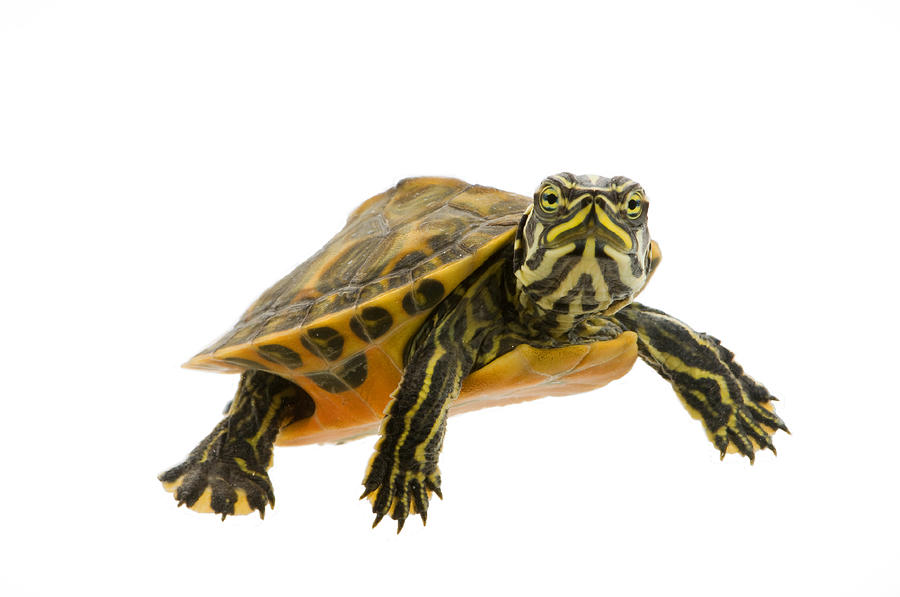
The most common species of aquatic turtles are red-eared . In home aquariums, they also keep marsh, matamata, caiman, spotted aquatic, tuberculate, European aquatic, black-bellied three-keeled, shield-footed, box, soft-bodied turtles.
Each species may have its own nuances of care, let's talk about the general principles of keeping aquatic turtles in home aquariums.
Turtle tank
Size. Aquatic turtles need a fairly large aquarium. In general, the turtle shell should cover a maximum of 25% of the bottom area of the aquarium. It's also a good idea to have an extra tank to feed the turtles to keep the aquarium water clean.
Water purity. Periodically, the water in the aquarium should be completely replaced. For a turtle with a shell diameter of 10 cm and an aquarium volume of 40 liters, water changes should be carried out 2-3 times a week. With a volume of 200 liters - 1 time per week. If you install a filter, then the water can be changed less often. From time to time, you need to clean the surface of the inner walls of the aquarium with an abrasive sponge.
From time to time, you need to clean the surface of the inner walls of the aquarium with an abrasive sponge.
Temperature, oxygen saturation. It is not necessary to dechlorinate the water, but always use only settled water for the aquarium. Carefully monitor the temperature of the water in the aquarium. After changing the water, make sure the water is warm enough before releasing the turtle into it. Water should not only be clean and at the right temperature (24-28 ° C), but also saturated with oxygen.
Island. Ideally, the aquarium should contain two islands of land. On one, the temperature should be 28-32 ° C so that the turtle can warm up. Use an infrared lamp or an incandescent lamp for this. On the second, the temperature should be 24-25 ° C. The access to the island should not be made entirely of smooth material (glass plastics), otherwise the turtle will not be able to climb onto it.
To prevent turtles from getting out of the aquarium, the water level should be 10-18 cm below the edge, depending on the size of the turtle. You can close the aquarium with a net, but not with glass.
You can close the aquarium with a net, but not with glass.
What to feed aquatic turtles
Most diseases of aquatic turtles is associated with malnutrition, so it must be complete and balanced. Aquatic turtles are carnivores, but this does not mean that their diet should include only meat. The feeding of an aquatic turtle depends on the species to which it belongs, it is necessary to take into account individual characteristics: some need a predominance of vegetables and fruits, others need vegetation, and others need meat. In addition, the diet depends not only on the species, but also on the individual preferences of each particular turtle.
Feeding base : live fish, earthworms, snails, molluscs, bloodworms, carriage, squid meat, shrimp, raw liver, lettuce, carrots, clover, vegetables, fruits, duckweed, spirogyra.
Turtle feeding in adulthood is carried out 2-3 times a week. Young turtles need to be fed every day. The problem of water purification is connected with feeding. To prevent clogging of the filter, do not feed too much and do not use too fatty food.
The problem of water purification is connected with feeding. To prevent clogging of the filter, do not feed too much and do not use too fatty food.
All turtles can be divided into aquatic and terrestrial. Aquatic turtles are popular pets. Due to the fact that land turtles are listed in the Red Book, and their official sale is prohibited, turtle lovers can only keep water turtles at home.
Many people know only about turtles that they eat animal and vegetable food, some live on land, while others live in water. In fact, there are more than 300 species of turtles on the planet and almost half of them are aquatic.
Turtles have been observed since ancient times. For example, the Greeks and Romans noticed that these animals are very prolific, so in ancient culture they were considered a symbol of fertility. As a result, turtles often accompanied Aphrodite in frescoes.
And in Europe they noted that turtles are characterized by longevity, so they personified health.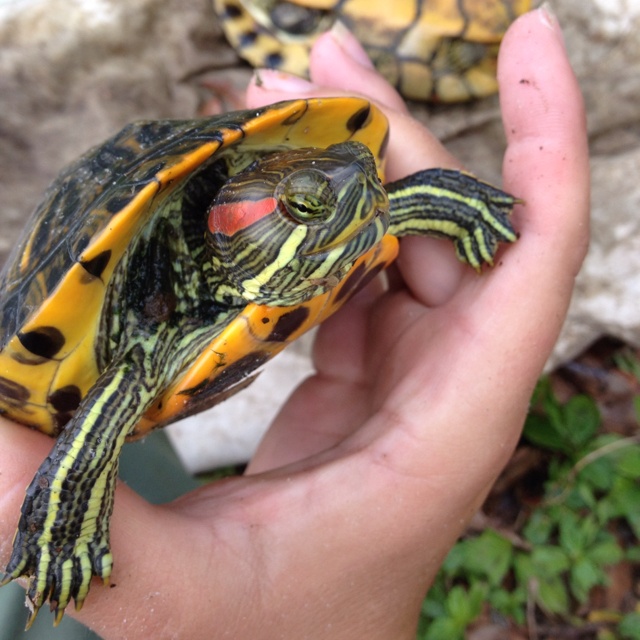 The Japanese thought that some turtles could live for 12,000 years, it was considered a good sign to keep a symbol of long life at home, and turtles were even betrayed from generation to generation.
The Japanese thought that some turtles could live for 12,000 years, it was considered a good sign to keep a symbol of long life at home, and turtles were even betrayed from generation to generation.
With the accumulation of scientific knowledge about turtles, the mysteries around them were dispelled and these creatures no longer seemed semi-divine, but, nevertheless, today many keep water turtles at home. Most often, inexpensive and affordable species are found in terrariums: Chinese trionics, red-eared turtle, European swamp turtle. These turtles differ in appearance and lifestyle.
Varieties of water turtles and features of their appearance
Red-eared turtles, bog turtles and trionyxes are very numerous, they live in various parts of the world: in Central America, USA, Mexico, Africa, Northern Iran, Turkey, Guadeloupe, Korea, Vietnam, Japan, Israel, Europe, Ukraine, Latvia and in the Far East.
Turtles are small. The largest is the red-eared turtle - its body length can reach 50 centimeters.
These tortoises have red spots around their eyes, from which they got their name, but, curiously, not all representatives have such spots, some of them are brown or yellow. The body color of red-eared turtles varies from black to bright green. Young individuals are green, and by old age their color darkens significantly.
Red-eared turtles are so popular because of their small size. Trionyxes outwardly differ from red-eared and bog turtles. Trionics are soft-bodied turtles. The shell is small - about 30 centimeters in length. The shell does not have a horny cover, it is covered with skin with small spikes, which gradually disappear.
The peculiarity of the Trionyx body structure is related to their way of life: they may not rise for air for more than 20 hours. Such incredible abilities in a reptile are provided by additional respiratory organs: the villi in the pharynx and in the oral cavity, which perform the function of a kind of gills. And thanks to the developed network of capillaries, breathing through the skin is ensured.
European bog turtles also have a certain peculiarity. These are the only turtles that can live at a cool temperature - 17-20 degrees. In nature, they spend a lot of time on land, and they plunge into the water in times of danger or in search of food. They try to stick to water bodies and do not leave them for long distances.
As with other water turtles, the bog turtle needs moisture to live: thanks to it, the skin does not dry out and skin diseases do not develop. Although European bog turtles have strong shells, they are very delicate creatures and require proper care.
How to keep water turtles at home
The growth rate of turtles throughout life is not the same, it is affected by the conditions of detention. Turtles grow quickly when young. If they are kept in a large terrarium, then every year they can add 10 centimeters, and with age, the growth rate slows down and does not exceed 1-2 centimeters.
Turtle tank should be quite spacious.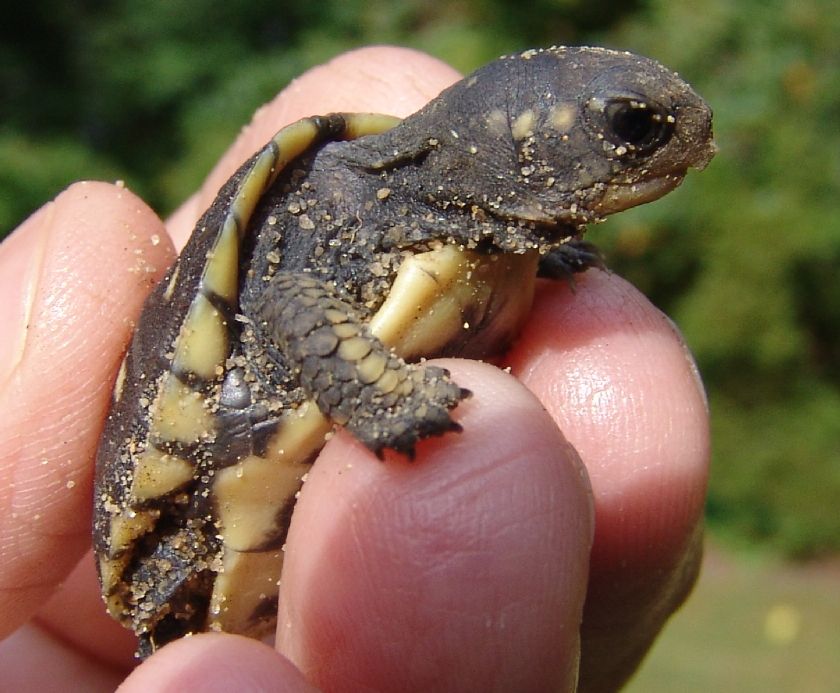 For one individual, an aquarium of 150-200 liters is purchased.
For one individual, an aquarium of 150-200 liters is purchased.
Although Trionyx, red-eared and bog turtles spend a lot of time in the water, they need dry land. You should make such a site so that the turtle can completely fit on it, dry and rest. That is, one part of the terrarium is left dry, making a mound of stones in it. Water turtles taste everything, so small pebbles cannot be used as soil. All decorative elements in the aquarium should be about 2 times the size of the turtle's head.
Due to the waste products of reptiles, the water quickly gets dirty, therefore, in order to cope with this problem, it is necessary to install an external filter in the terrarium.
An obligatory component of the terrarium is an ultraviolet lamp. For these turtles, a lamp marked with 8-10% radiation is sufficient. The lamp should be left on daily for 12 hours, then the reptile will feel great.
Turtle diet
All water turtles are predators. They do not eat fruits and vegetables, their diet consists of lean meat, fish and seafood.